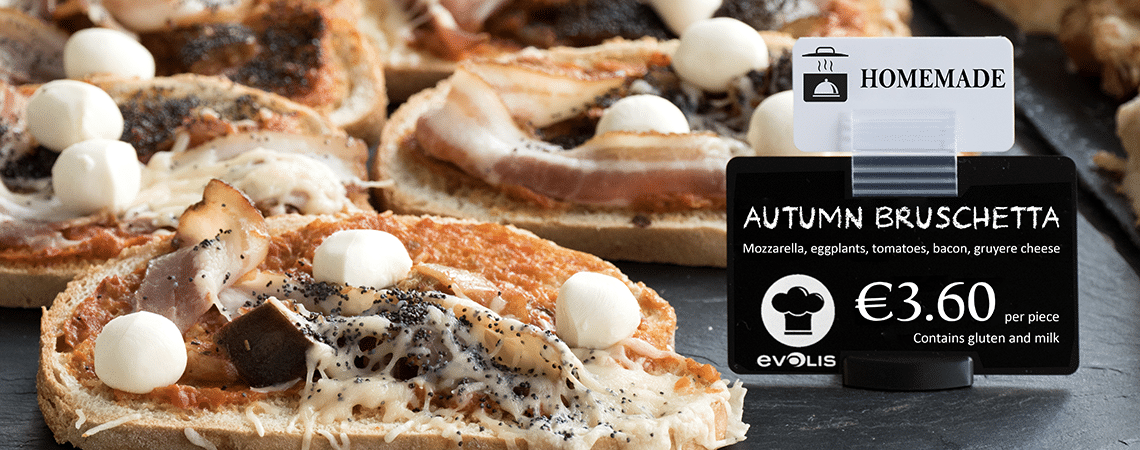The number of people worldwide suffering from food allergies is increasing every year. The reasons for this trend are not entirely known, but many experts point to the high level of hygiene in modern societies and food processing as likely causes.
Most allergic reactions to food are only mild and can be treated with over-the-counter antihistamines, but some can be life-threatening and require emergency medical treatment. Therefore, displaying important allergy information on food products is an important responsibility for manufacturers and supermarkets today.
Although many products already display allergen information on their packaging, there are cases where the information is unclear or confusing. That’s why we’re looking at the most effective ways of displaying food allergy information using easy-to-read price cards and point-of-sale displays, to help your customers make informed purchasing decisions, reducing the risk to allergy sufferers and enabling you to build customer confidence.
Offer a varied and dynamic range of products
On average, a European consumes 59 kg of bread a year. This figure has been falling for several years. However, it is also giving way to new consumer habits. While the traditional activity of a bakery is selling bread, the range of products on offer in your shop has certainly evolved in line with your customers’ buying habits.
We don’t all eat the same bread, but the demand is there!
Pastries, chocolates, snacks, confectionery… these are all products for sale that get your customers used to making purchases other than their daily bread. They also allow you to stand out from the crowd, so your first challenge will be to renew your offering.
What is food allergy information?

The 8 most common ingredients causing food allergies
A food allergy is a condition in which certain food ingredients trigger an abnormal immune response. A number of different ingredients can trigger this reaction, but only eight are responsible for the majority of food allergy reactions worldwide. Good to know:
- Eggs
- Milk
- Nuts
- Peanuts
- Seafood
- Wheat
- Soya
- The fish
All these elements should be subject to allergy labelling, even if food products contain only traces of them. The FDA and other food safety authorities in the world require food labelling to clearly indicate the source of any ingredient that is one of the main food allergens, or contains proteins derived from these allergens.
In addition to precise product descriptions, it is now common practice to use allergy price cards and point-of-sale displays that highlight the existence of these ingredients in products, to ensure that all consumers have all the information they need when they go shopping.
Additional food allergens
In addition to the eight most common food allergens, there are a number of ingredients known to cause allergic reactions in individuals. These include celery, sesame, lupin and mustard. If you think you may be allergic to a particular ingredient, consult your doctor to confirm.
Although it is not compulsory to create displays and price cards highlighting these allergens, it does help people with a food allergy or intolerance to make safe choices, particularly when buying pre-packed foods sold in supermarkets.
In recent times, consumer habits have changed dramatically. However, the bakery remains a local business that customers like to visit. To maintain this advantage, developing new distribution channels is a real challenge if you want to stand out from the crowd, retain your existing customers and attract new ones.
- Presence on social networks,
- Click & Collect,
- Deliveries
You may have taken advantage of the health crisis to develop and test some of these services. Now you need to make them your own to maximise their impact on your sales. Aesthetics are very important in the bakery business. The quality of the product, its production, the craftsman’s know-how – aesthetics also reflect the image of a well-kept business. The image of your brand and the beauty of your products are points that you can easily promote online, on social networks thanks to beautiful photos. Make the most of it, and you’ll be able to engage in discussion with customers or make yourself known in a different way.
Clear, transparent allergen and price cards
Clear, transparent allergen and price cards
As well as displaying important allergy information, your price cards should also contain detailed product information and promotional messages to attract shoppers and communicate the value of your products. This can be tricky when you have a lot of information and little space to convey it.
When there are too many words on a price card, it can increase the buyer’s cognitive load as they circulate. At best, this will reduce the ability of your price cards to inform the buyer of the important benefits of the product. At worst, people will simply turn away from your product because they don’t want to bother reading a complicated display.
You’ll need to strike a balance between detailed information on the one hand, and ease of reading and attractiveness on the other. To do this, use price card styles and information layouts strategically to balance allergy information with product descriptions in your supermarket or food shop.
Give allergy-related information the space it deserves by using appropriate font sizes
It’s not enough to put allergy information on your price cards in small print. Even if this allows you to emphasise the benefits of your product, it is more difficult for customers with allergies and intolerances to read the information they need. Highlighting information on allergens is precisely the opportunity to build a relationship of trust and respect with your customers.
If you can provide them with honest, transparent and useful advice to make their shopping experience easier, they will find it easier to trust your brand and become customers for life. Even customers without allergies will respect this effort. What’s more, older people or those with poor eyesight will particularly appreciate it if you highlight important allergy information so that they can read it without tiring.
Why make allergy price cards and point-of-sale advertising easy to read?

Use allergy symbols to quickly inform customers of important information
A number of standard allergy markers can be used to provide shoppers with an easy visual signal that certain foods or drinks contain potentially dangerous allergens. These visual symbols can be used to quickly inform a person that a product may contain an element to which they are allergic.
Human beings process images 60,000 times faster than text, and 90 % of the information transmitted to the brain is visual. The use of specific allergy symbols instead of simple text descriptions is a fundamental strategy used in product labelling.. Buyers with food allergies or intolerances now have a quick way of checking whether products are safe to eat.
This method also allows you to save space on your price cards thanks to the small size of the allergy symbols, giving you valuable space to concentrate on the benefits or style of the product. After all, too much information on a card or POS can overwhelm or deter a shopper. Take a look at the standard allergy symbols in our price card information guide to create your own allergy-friendly supermarket price cards.
Use tables to clearly organise information about allergies
As well as using allergy symbols, you can create an organised table to display allergy information for certain products. Instead of listing each item one by one, in no particular order, you can use a clear, easy-to-understand structure to improve visibility and reduce the time shoppers have to spend looking at your products.
At the end of the day, people like to shop as quickly as possible and helping them get the information they want more quickly will improve their customer experience. If your allergen information is hidden or confusing, it’s easy for customers to become impatient. At the same time, clear and prominent information on price cards in your shop will help to streamline the buying process, reduce the risk of complaints and increase the likelihood that customers will trust and respect your brand.
Whether it’s information about allergens or product benefits, remember that you should always approach your shop’s visual branding from the customer’s point of view. Create your price cards and POS materials with your customers’ concerns and motivations in mind and you’ll stand a good chance of building trust and a genuine relationship, turning occasional shoppers into lifelong fans.
